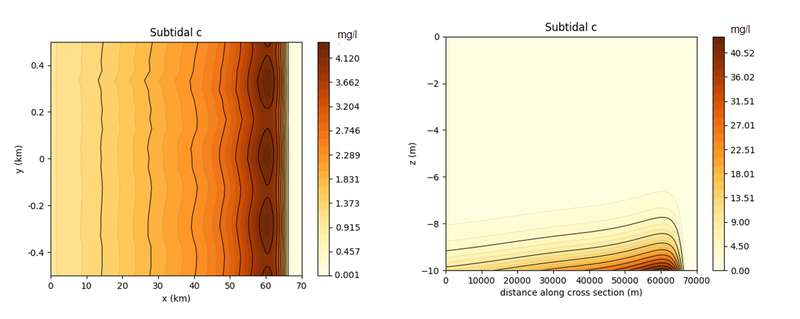M.P. Rozendaal1*, Y.M. Dijkstra1 , H.M. Schuttelaars1
1Delft Institute of Applied Mathematics, Delft University of Technology, The Netherlands;
*Corresponding author: M.P.Rozendaal@tudelft.nl
Introduction
The complex bathymetry and geometry of estuaries greatly affects the water motion and suspended sediment dynamics. The complex structure of the lateral bathymetry induces complex three-dimensional flows, that, in turn, drive complex three-dimensional sediment motion. Sediment tends to accumulate in the regions where the transport of sediment converges (Kumar, 2018). If the convergence is strong enough, a region may be formed where the levels of suspended sediment are highly elevated: an Estuarine Turbidity Maximum (ETM). Even though much attention has been given to the formation and dynamics of ETMs (see, e.g., Huijts, 2006), the influence of lateral bathymetry and dynamics on the formation of ETMs remains poorly understood. To improve our understanding, an idealized modeling approach is taken, where only the essential processes are taken into account. This allows us to gain fundamental insights into the physical processes governing sediment dynamics. Moreover, the idealized approach allows us to build a highly specialized model which is fast such that extensive parameter sensitivity studies can be performed.
Objective and Methods
To study the lateral dynamics, iFlow3D is constructed, which is a three-dimensional idealised hydro and sediment dynamic model. This model can effectively handle highly realistic and complex geometries and bathymetries. Using Fourier analysis, the harmonic components of the water motion and suspended sediment concentration can be directly identified and computed, e.g., M0, M2, M4 etc., without the need for time stepping methods and spin up time. Using these harmonic components, individual transport processes can be identified and the net sediment transport can be computed. Using the concept of morphodynamic equilibrium, a dynamic equilibrium distribution of sediments can be determined and ETMs identified. The resulting model is fast enough such that parameter sensitivity studies can be performed and the parameter space explored.
Results
We consider the sensitivity of the sediment transport and the lateral sediment distribution to changes in the lateral bathymetric profile. We explore several bathymetric shapes from a rectangular profile to a Gaussian profile with pronounced channels and shallow areas, and we investigate the effects of width convergence. The general trends of the sediment distribution will be explained in terms of the underlying flow and transport processes.

Fig 1. Preliminary results of the subtidal Suspended Sediment Concentration (SSC) in a rectangular estuary with a flat bed and prescribed salinity field. Here, x is the longitudinal coordinate, y the lateral coordinate and z the vertical coordinate. Left, top view of the depth-averaged SSC and right, a longitudinal cross-section of the SSC at y=0.
References
K. M. Huijts, H. M. Schuttelaars, H. E. de Swart, and A. Valle-Levinson. Lateral entrapment of sediment in tidal estuaries: An idealized model study. Journal of Geophysical Research: Oceans, 111(12):1–14, 2006. doi:10.1029/2006JC003615.
M. Kumar. Three-Dimensional Model For Estuarine Turbidity Maxima In Tidally Dominated Estuaries. PhD thesis, Delft University of Technology, 2018.


